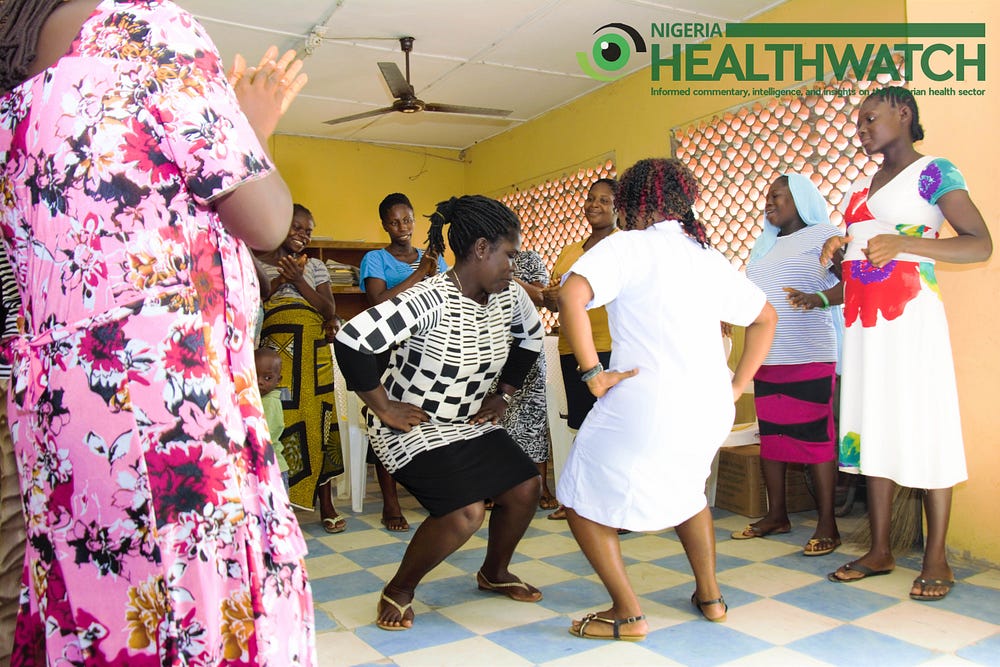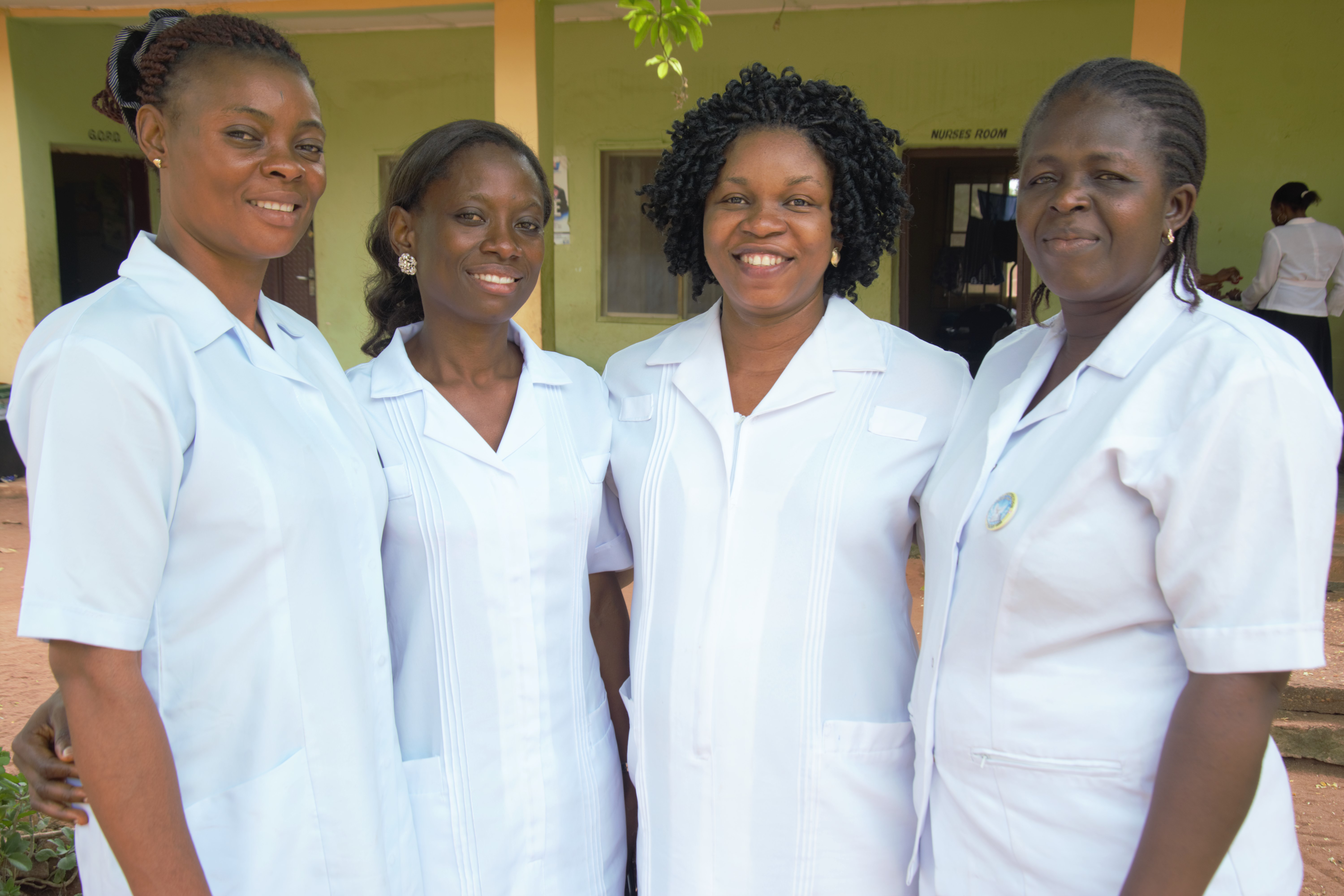Nigeria’s Minister of Labour, Dr. Chris Ngige, recently made waves when he asserted that he was not worried about doctors leaving Nigeria, because the country has a surplus. The comment spurred outrage and extensive commentary about whether Nigeria actually has enough health workers. In an interview on Arise TV, Dr. Ifeanyi Nsofor, Nigeria Health Watch Director of Policy and Advocacy, pointed out that it’s important to look at the data. “We have 72,000 doctors registered with the Medical and Dental Council of Nigeria (MDCN), with 35,000 in Nigeria. Even if we have all the 72,000 present in Nigeria, it will still not be enough because we actually need above 300,000 doctors to meet the World Health Organisation (WHO) recommended ratio,” he said.
Who then fills this gaping void in Nigeria’s human resource for health? The other cadres of health workers, most notably nurses and midwives. With the incredible shortage of doctors, this cadre becomes quite important, and successive administrations have put in place schemes meant to ensure that nurses and midwives are present in health facilities. Having skilled health personnel available at the health centre is critical for quality maternal and child care. While several factors are important to revitalize Nigeria’s primary health care sector, human resource for health must become a central concern for the incoming administration, if Nigeria is to make any appreciable progress in our maternal and child health indices.
Past administrations have introduced schemes meant at improving healthcare, from primary health care to maternal health. Yet, a lack of continuity between governments means that every time there is a change in government (or political party), we all prepare to hear about new initiatives in primary health, maternal and child health, including the corresponding acronyms. In the last 10 years, Nigeria has run three different schemes meant to increase the availability of skilled birth attendants at primary health centres, to provide maternal and child health services. While each has had a measure of success, each has also been plagued by recurring challenges, most persistent of which seems to be that funding these schemes does not seem to be a priority, most notably at the state level.

In December 2009, the Midwives Service Scheme (MSS), managed by the National Primary Health Care Development Agency (NPHCDA), was designed to mobilize midwives, including newly qualified, unemployed and retired midwives, for deployment to selected primary health care facilities in rural communities. Midwives were deployed for one year to selected PHCs in rural communities. The program’s goal was to double the proportion of deliveries attended to by skilled birth attendants, in order to reduce the rates of maternal and infant mortality in target areas by 60%, by December 2015. Phase 1 of the MSS took place in 652 primary care clinics across all of Nigeria’s 36 states, serving more than 10 million people. The MSS was funded by a special MDG-DRG (Debt Relief Gains) Account. Midwives were paid N30,000 a month by the Federal Government. In addition to this N30,000, states were originally mandated to pay N20,000, while local governments were asked to pay N10,000 and to provide accommodation, security and welfare for the midwives. A majority of the states, about 60%, did not keep to the terms of the MOU, Dr. Ngozi Nwosu, Head of Human Resource for Health, NPHCDA, said.
In 2013, the Subsidy Reinvestment and Empowerment Program Maternal and Child Health (SURE-P MCH) initiative kicked off, focused on increasing access to maternal and child health services, through a continuum of care for pregnant women and their new born babies. It was meant to build on the best practices of the MSS Scheme, which had by then run into some funding challenges. MSS midwives were leaving the scheme and moving to SURE-P because the pay was better, and they were being owed salaries under MSS. Their salaries were unpaid because under the scheme, the counterpart funding from the Federal government was supposed to transition to the state governments progressively, however the states were not able to fund the Federal government portion of the midwives salary.

Photo source: Nigeria Health Watch
SURE-P MCH had two main components;
- tackling the ‘supply’ of services, to restore the infrastructure in selected PHCs through the renovation of health care facilities, supply equipment and medicines
- increasing the number of trained health workers able to provide care at the health facilities, including midwives, community health extension workers (CHEWs) and village health workers (VHWs).
Midwives were to be paid N40,000 by the Federal Government, CHEWs were paid 25,000, and Village Health Workers received a N10,000 stipend. State governments were encouraged to support the health workers but no specific amount was mandated in the MOU, and local governments were supposed to provide accommodation and security and welfare. Some state governments agreed to support but many did not pay the midwives in the scheme.
In March 2015, public health consultancy firm EpiAFRIC conducted a mid-term evaluation to assess the progress and achievements of the SURE-P MCH Programme and to provide recommendations for the post-2015 period. The evaluation, which sampled one state in each geopolitical zone, showed that the inputs of the SURE-P MCH project helped selected facilities increase antenatal care visits, deliveries by skilled birth attendants, and the number of babies given OPV, HBV and BCG vaccinations at birth. Most people interviewed felt that SURE P MCH was a well-intentioned programme addressing an important health need in Nigeria. Renovated health facilities, provision of free medication and new equipment for maternal care delivery was evident in the facilities visited.

Photo source: Nigeria Health Watch
Most importantly, a new cadre of highly motivated midwives and CHEWS were deployed. Most of the midwives and CHEWS that joined the scheme were young and enthusiastic graduates. Also, a contributory factor to SURE-P’s success was the work of the village health workers. They were tasked with going into the community and encouraging women to come to the health facilities for care during their pregnancy and after they give birth. These village health workers were supported by Ward Development Committees (WDC). In some communities, village heads supported midwives and CHEWS with accommodation.
The 2015, the elections saw a change in Nigeria’s political leadership. Midwives, both those under SURE-P and those under MSS were meant to be absorbed into the health system of states where they were working. But already battling with unpaid existing health workers, many states either could not or would not take on the responsibility of employing the midwives. In addition, those midwives who did get jobs were usually sent to general hospitals, leaving PHCs in rural areas.
In 2015, the current administration tried to rekindle the MSS programme which had some success in ensuring skilled birth attendants took delivery of pregnant women in the facilities covered by the programme. Due to funding challenges resulting from the closure of the MDG grant, this new targeted MSS was on a smaller scale and deployed only newly graduated Basic Midwives to underserved Primary health centers for a one-year compulsory community midwifery scheme. An MOU was signed between NPHCDA and the Nursing & Midwifery Council of Nigeria to closely monitor and supervise these midwives who had completed two years of basic training from their schools. Given the previous challenges in getting the states and LGAs to pay the counterpart fund they agreed to in the MOU of the former scheme, the Federal Government undertook to pay the Basic Midwives N30,000 a month, while encouraging their host states and communities to also provide some incentives. In March 2018, the NPHCDA is reported to have deployed 1,181 midwives to primary health centres across the country. That tranche of midwives, who were the last batch in the scheme, completed their mandatory one-year service in March 2019. There are currently no midwives deployed under the scheme.

Photo source: Nigeria Health Watch
Head of Human Resources for Health at NPHCDA, Dr. Ngozi Nwosu, said the Agency is proposing to start the Expanded MSS scheme (EMSS). According to her, “this expanded scheme will use experienced but unemployed midwives as well as interested unemployed basic midwives and Community Health Extension Workers (CHEWs). Such CHEWs must have been trained in Life Saving Skills and Basic Emergency Obstetric Care.” Dr. Nwosu added that “While the original MSS Scheme deployed four midwives per facility, we are proposing that the Expanded MSS Scheme would deploy two Midwives and two CHEWs to each of the PHC centres to reduce cost.” Instead of the 1000 health facilities covered by the original MSS Scheme , Nwosu says the Agency plans to expand the number of facilities in this scheme to ensure the programme makes maximum impact. “We have tested the MSS Scheme as a proof of concept and we want to let people know that it has worked”, she said.

As for funding, which has been the bane of the past Midwifery service schemes in the country, the Expanded MSS Scheme is meant to be primarily funded through the Basic Health Care Provision Fund (BHCPF) even though States, the private sector, partner development agencies and other stakeholders are encouraged to contribute to ensure the programme works, Nwosu said. “We hope to tap into the funding for Human Resources for Health in the BHCPF which will be routed through the states. Knowing the importance of Midwives and other human resource in reducing maternal and child deaths as well as ensuring the success of the PHC Revitalization Agenda and Universal Health Coverage, the NPHCDA plans to work with the states to ensure this programme works,” she said. The HRH Funding in the BHCPF also has a requirement for 25% counterpart funding from the states which is another window for funding.
This may well deal with the propensity of states to default on the payment of midwives. In the meantime, Civil Society Organisations (CSO) like the Wellbeing Foundation Africa, MSD for Mothers and MamaYe have been playing an active role in plugging the gaps in training, upskilling and supporting the employment of midwives in health facilities. The MamaCare — Midwifery Initiative uses qualified midwives to deliver antenatal care to expectant mothers; a critical intervention to reduce maternal and infant mortality.
As the NPHCDA works to put in place interventions such as the Community Health Influencers Promoters & Services (CHIPS) Program to increase demand generation and the National Emergency Maternal and Child Health Intervention Centre (NEMCHIC) to cut maternal mortality in half by 2021, those on the front line of providing health services in Nigeria’s over 20,000 primary health centres should not be ignored. None of these interventions are achievable without addressing the critical issue of human resources for health.



This is indeed a master peace, it captures the true scenario of happenings across the States of the country at the PHC level which for so long hampers effective, efficient and sustain integrated PHC service delivery to women and children of our dear Nation, something needs to be done in earnest.
Thanks